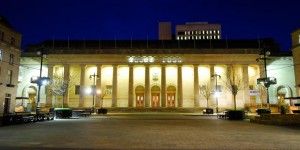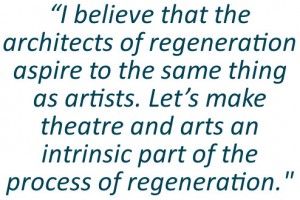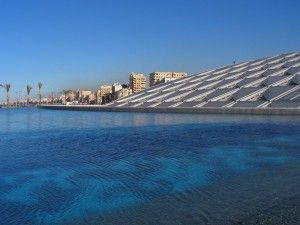The National Theatre of Scotland, which this week announced plans to establish a new operational hub in a regeneration area of north Glasgow, has a long-standing interest in community regeneration. In this article, Simon Sharkey provides an overview of the extensive contribution that theatre can – and does – make to physical, social and economic regeneration approaches at home and abroad.

In Time O’Strife – a recent NTS production focused on a Fife mining community in the 1920s
On 25 February 2006, the National Theatre of Scotland (NTS) Launched with ten productions across Scotland. From Shetland to Dumfries, communities and artists united to make theatre that was for by, with and about them.
Not one of the productions took place in a traditional theatre and all of the productions included a cast made up of professional and community members. The success in terms of connecting to a sense of place, identity and belonging was phenomenal.
We describe the theatre we make as “Theatre Without Walls”. Nine years on and we have produced over 180 shows and played across four continents, reaching an audience approaching two million. Our approach has seen us grow into an internationally renowned company with a unique model that is being adopted by other companies and countries.
Community Theatre, Community Regeneration
 At the heart of this success is partnership and people. The unusual partnerships we have enjoyed have enabled us to make distinctive, amazing theatre that transforms lives. This transformative power of theatre plays a major and unique role in regeneration.
At the heart of this success is partnership and people. The unusual partnerships we have enjoyed have enabled us to make distinctive, amazing theatre that transforms lives. This transformative power of theatre plays a major and unique role in regeneration.
“Theatre Without Walls” is deliberately and explicitly open about how we define the experience you will have if you come to see, or are involved in, the making of a piece of NTS theatre. We approach our definition of communities in the same way. Our communities do not necessarily see themselves as the demographic or social profile that they fit in to, e.g BAME, NEET, AMD.
They are individuals or groups who are multi-faceted and undefinable. This is the joy and value of theatre. It gives us form and structure to share in the telling of story; to share in the expression of who we are and what is possible. It is democratic and accessible and reflects the diversity of an individual as well as a community.
Self and Other

Dundee was the 13th international city to be awarded UNESCO City of Design status
Theatre allows us to celebrate the unique profile of a community and foster a sense of belonging, understanding and, most importantly, empathy. It is the place and space where we encounter the “other” and learn from the story or journey they take within a narrative structure that transports us into possibility.
We laugh and cry, are thrilled and challenged as we follow the story and the action. We see what is possible, and in the case of participatory theatre we are active in the creation of that possibility.
In any encounter we have with the “other”, we are changed. Our perceptions, preconceptions expectations are informed or educated, our aspirations are enlightened, our ambition is empowered and we discover. We are transformed.
I believe that community regeneration is about transformation. Social, architectural, economic, educational and cultural designs are driven in order to change the perceived or actual challenges a community faces. In regenerative transformation, we are building opportunity and encouraging aspiration, ambition, innovation, empowerment and responsibility to build a new narrative.
If we begin our designs from the viewpoint that social mobility is desirable, poverty should be eradicated, violence needs to be reduced, health should be improved and so on, then we are engineers of a paradigm of opportunity. What we are not in control of is the context that individuals and communities approach or seize the opportunity. We cannot manufacture expectation, aspiration, ambition or innovation, we need to recognise these attributes as intrinsic drivers and inform them or awaken them. This is what theatre does.
Tumbleweed or Standing Ovation?
Where does social engineering and art sit in terms of creating policy that helps engineer the opportunities and create the contexts through which communities engage or write their own narrative? It is my firmly-held belief that policy should enable, not dictate. It should be flexible and responsive, and often is. However, it is constrained by budgets and targets and by measuring success through criteria that is tangible such as shifts in social norms, strengthened organisational capacity, strengthened alliances, and changes in impact.

Brazilian theatre is credited with improving community safety
An interesting read in terms of measuring a policy’s effectiveness is the Nesta-commissioned Whose Story is it Anyway?. There are countless other examples and ways of measuring the success and effectiveness of a policy. What we find in each of these examples is criterion set as objectively desirable outcomes and outputs. What we don’t measure so successfully is the subjective or transformational narratives of the individuals and communities that have been active in delivering and receiving the benefits of the policy.
With theatre, we have an immediate response. There is an instant reaction as people burst into applause, or remain in silence. The cast or participants know intrinsically if they are part of a success or not. The very act of gathering to witness is a statement of intent, of openness to change. The cast know if their design and moment of suspended animation is working. It gives authentic voice to all. It creates space for debate. Even for the inarticulate, they are able to participate emotionally and have their presence felt and shared. It allows forms of expression that would not otherwise be considered.
Theatre frees us from the restrictions of measuring our outputs and outcomes, because intrinsically we all experience the humanity. We contextualise through emotion and intellect and empathise, which in turn binds us, connects us and allows us collectively to embrace change and re write the narrative. This, within the context of rehousing, or new super schools, or shopping centres being built or demolished, or sporting facilities or motorways springing up where communities once stood, is an absolute essential if change is to be seen as opportunity instead of disruption and disenfranchisement.
Global Inspiration
I can cite hundreds of cases where theatre has made a significant physical, cultural, social and economic impact on national and local communities. I had the privilege of being part of a city-wide regeneration initiative in Alexandria, Egypt, where the introduction of the UNESCO sponsored library gave birth to a theatre festival. This changed the fortunes of the city and can lay claim to the beginnings of the Egyptian Arab Spring.
In Singapore, I was involved with a company that helped change the dictatorial attitudes of government towards freedom of expression whilst the city was being reinvented as a shopping and cultural paradise to attract world trade and tourism. I recently returned from Jamaica, where we were invited to work with ghetto kids and help change attitudes towards economic migration so that Kingston’s ambition to be a world centre for logistics for the burgeoning South American economies can begin to be imagined.
In Malta, we are working with a very small theatre infrastructure, which is part of a strategy that won capital Valletta the 2018 European City of Culture. In Brazil, it is theatre that is helping pacify the favelas and make Rio de Janeiro a safer and more prosperous place that is capable of hosting two of the world’s biggest sporting events. In India, we are working with a company that takes orphans off the streets and trains them in street theatre so that the roads of Dehli, whilst the city booms, are not only animated with beggars but with entertainment.

A Theatre of Opportunity

The UNESCO sponsored library in Alexandria was used to launch a notable local theatre festival
At home, we have worked across 29 local authorities and created amazing and original theatre that has galvanised and engaged communities in the rewriting of their narrative. In Port Glasgow, we worked across two schools that were to be merged as part of the regeneration of the area and the building of a new super school. It was considered impossible to bring the two communities together. Theatre proved otherwise.
In Dundee, we are working in partnership with the growing digital gaming sector and local Dundee Rep theatre to re imagine the city as it celebrates becoming a UNESCO City of Design. In Aberdeen, we are planning the most ambitious production we have ever created with a community. The goal is to build civic pride and confidence in the city’s cultural offer so that Aberdeen is recognised not only as a powerhouse economy, but a place to live as well as work. A place equal to any other Northern European city.
In all of these instances, we are totally reliant on the people and their willingness to tell us their story. It is the collective gathering, forming and sharing of a narrative that allows us to measure and shape our lives.
Architects, town planners, regeneration companies understand the power of a narrative; they design the possibility of new narratives through infrastructure and physical & social engineering. There is great creativity in imagining these changes. There is infinite possibility in theatre as a space to belong, to gather and share, and in doing so to transform.
I’m an optimist. I believe that the architects of regeneration aspire to the same thing as artists. Let’s make theatre and arts an intrinsic part of the process of regeneration. Let’s start by gathering round a common ambition of educating, enlightening, empowering and innovating. Let’s establish what I call a “Theatre of Opportunity”.
